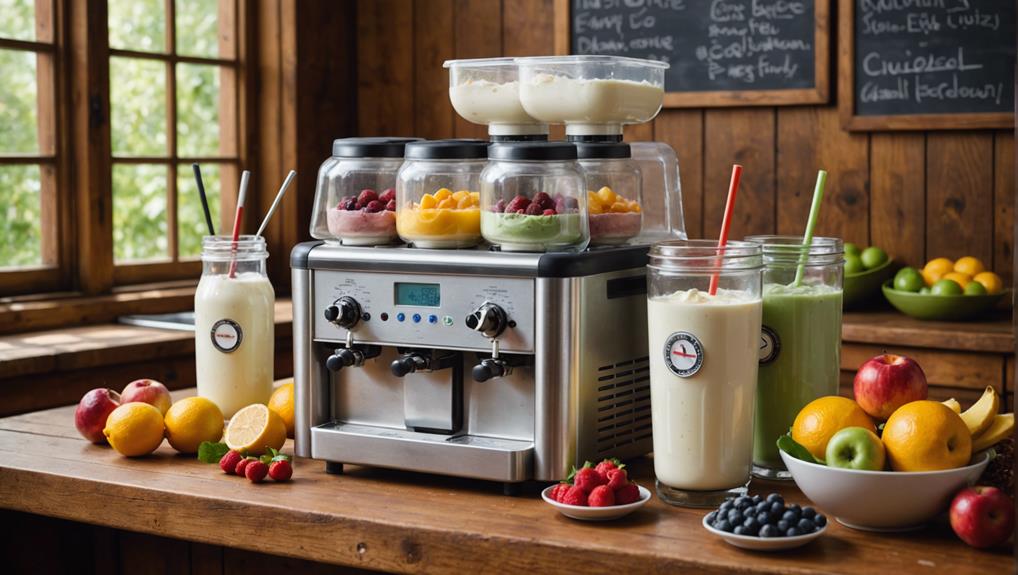In frozen yogurt production, air incorporation, known as overrun, is pivotal for achieving a smooth and creamy texture. Proper air inclusion, generally 30-40% in the freezing cylinder, prevents icy and dense consistencies by inhibiting large ice crystal formation. The air tube in gravity-fed machines ensures continuous and precise air integration into the yogurt mix. Regular maintenance and correct positioning of this tube are essential for maintaining texture quality. Variations in soft-serve machines further influence texture through different air injection capabilities. Understanding these variables is essential for producing premium frozen yogurt and maintaining consistent product quality. Discover further technical details and optimization techniques.
Key Takeaways
- Proper air incorporation is crucial for a smooth and creamy texture in frozen yogurt.
- Overrun, the process of integrating air, prevents the yogurt from becoming icy and dense.
- Ideal air content in the freezing cylinder should be 30-40% for optimal texture.
- Gravity-fed machines use air tubes to introduce air consistently, enhancing smoothness.
- Regular maintenance and correct positioning of air tubes ensure consistent frozen yogurt quality.
Importance of Air in Frozen Yogurt

The inclusion of air in frozen yogurt is essential for creating the desired smooth and creamy texture that defines high-quality products. This process, known as overrun, involves integrating air into the yogurt mix during freezing. Proper air inclusion is vital for avoiding an icy and dense consistency, which can detract from the overall consumer experience. The freezing cylinder, an important component in this process, should ideally contain 30-40% air to achieve the best texture.
Soft-serve machines play a significant role in determining how much air is added to the frozen yogurt mix. These machines vary in their capability to inject air, impacting the final product's texture. High-quality soft-serve machines are designed to maintain a consistent air-to-mix ratio, ensuring that the frozen yogurt remains smooth rather than becoming icy and dense.
Air's Effect on Texture
Incorporating the appropriate amount of air during the freezing process greatly influences the texture of frozen yogurt, guaranteeing it remains smooth and creamy rather than dense and icy. Proper air content, typically around 30-40%, is crucial for achieving excellent results in frozen desserts. This controlled incorporation of air during the freezing phase not only enhances the sensory attributes but also prevents the formation of large ice crystals, which can degrade the product's quality.
Different soft-serve machines employ various techniques to introduce air into the yogurt mix. By doing so, they ensure a consistent and smooth texture that meets consumer expectations. Understanding and managing air content is particularly important for natural frozen yogurt mixes, which may lack stabilizers and emulsifiers found in other formulations.
Key factors influenced by air content include:
- Smooth texture: Proper air incorporation prevents iciness.
- Volume: Increased air content leads to higher overrun and volume.
- Mouthfeel: Enhances the creamy sensation.
- Storage stability: Reduces ice crystal growth over time.
- Consistency: Guarantees uniform product quality across batches.
Maintaining Creamy Consistency

Achieving and maintaining a creamy consistency in frozen yogurt necessitates precise control over air incorporation throughout the freezing process. Effective air incorporation is crucial to achieving the desired smooth and creamy texture that consumers expect in high-quality frozen yogurt. The ideal air content within the freezing cylinder should typically be maintained at 30-40%. This balance guarantees that the frozen yogurt does not become dense and icy, which would detract from its appeal.
Soft-serve machines play a pivotal role in managing air incorporation. These machines are engineered to infuse air into the yogurt mix during the freezing process, thereby regulating the texture. The degree of air incorporation can be adjusted based on the specific design and settings of the soft-serve machines, allowing for the production of a consistently creamy product.
Natural frozen yogurt mixes particularly benefit from adequate air incorporation, as it enhances the creamy finish without the need for additional stabilizers or emulsifiers. Hence, proper calibration and maintenance of soft-serve machines are essential to preserve the delicate balance of air and mix, ensuring a premium frozen yogurt experience with each serving. By meticulously controlling these variables, manufacturers can consistently deliver a product with the ideal creamy texture.
Role of Gravity-Fed Machines
Gravity-fed machines play a pivotal role in frozen yogurt production by ensuring consistent texture and efficient ingredient mixing. The integration of air tubes within these machines introduces air into the mix, contributing to a smoother, creamier product. Proper placement and maintenance of these tubes are critical to optimizing machine performance and achieving desired product quality.
Consistent Texture Production
Ensuring a consistent texture in frozen yogurt production relies heavily on the efficient operation of gravity-fed machines, particularly the precise introduction of air through the carburetor tube. The air tube's role is critical for achieving a smooth and creamy consistency by preventing excessive ice crystal formation. Proper positioning and maintenance of the air tube within gravity-fed machines can greatly influence the final product's texture.
Several key factors contribute to consistent texture production in frozen yogurt:
- Air Tube Positioning: Correct placement of the air tube is essential to properly aerate the mix, ensuring smooth and creamy yogurt.
- Carburetor Tube Adjustment: Regular resetting of the carburetor tube can address issues like dense or icy textures, maintaining product consistency.
- Machine Maintenance: Routine monitoring and servicing of gravity-fed machines are essential for optimal performance and texture control.
- Air Introduction Mechanism: The precision of air integration via the carburetor tube directly affects the formation of ice crystals and overall texture.
- Operational Efficiency: Efficient use of gravity-fed machines ensures a uniform and high-quality frozen yogurt production process.
Efficient Ingredient Mixing
Leveraging the precision and efficiency of gravity-fed machines is essential in achieving the best ingredient mixing for frozen yogurt production. The carburetor tube, integral to these machines, introduces air into the yogurt mix, greatly influencing the final product's texture. Properly positioned, the carburetor tube ensures a smooth, creamy texture by maintaining an ideal air-to-mix ratio.
Gravity-fed machines utilize the following key components and considerations for efficient mixing:
| Component | Functionality | Impact on Texture |
|---|---|---|
| Carburetor Tube | Introduces air efficiently into the mix | Maintains a smooth texture |
| Hopper | Holds the yogurt mix and positions the air tube | Affects air mixing uniformity |
| Air Intake Hole | Allows air to enter the carburetor tube | Controls air incorporation |
| Air Tube Reset | Adjusts air intake by turning the tube over | Corrects dense/icy texture |
| Machine Rep | Provides guidance on optimal tube usage | Enhances machine performance |
The air tube must be accurately positioned within the hopper, with its intake hole properly exposed to air. If the frozen yogurt becomes dense or icy, resetting the air tube by blocking the intake hole can rectify these issues. Consulting the machine representative ensures the precise use of gravity-fed machines, maximizing the efficiency of air incorporation and promoting a consistently smooth texture in the final product.
Function of the Air Tube

The air tube mechanism in gravity-fed frozen yogurt machines introduces air into the mix, greatly influencing the texture enhancement process. By properly positioning the air tube, operators can guarantee a smooth, creamy product, crucial for maintaining consistent quality. Correct adjustment of this component directly impacts the final product's density and mouthfeel, highlighting its crucial role in frozen yogurt production.
Air Tube Mechanism
Incorporating air into the frozen yogurt mix is a critical function of the air tube, which plays a pivotal role in achieving the product's smooth and creamy texture. The air tube, also known as a carburetor tube, is an essential component in gravity-fed frozen yogurt machines. It is designed to facilitate the integration of air into the mix as it flows into the freezing cylinder.
The air tube operates by having one end inserted into the hopper, where the frozen yogurt mix resides, while the other end remains exposed to the air. This exposure allows air to be drawn into the mix as it descends into the freezing cylinder, ensuring a uniformly aerated product.
Key aspects of the air tube mechanism include:
- Component Design: A long, skinny tube with perforations on both ends.
- Positioning: Proper insertion into the hopper and correct exposure to air.
- Functionality: Maintains continuous incorporation of air into the mix.
- Machine Compatibility: Integral to gravity-fed machines but requires precise installation.
- Operational Integrity: Contact machine representatives if the air tube is absent to guarantee proper aeration methods.
Texture Enhancement Process
Understanding the role of the air tube in the texture enhancement process is essential for achieving the desired smoothness and creaminess in frozen yogurt. In gravity-fed machines, the air tube, also known as a carburetor tube, is a pivotal component that introduces air into the yogurt mix as it flows into the freezing cylinder. This incorporation of air is vital for producing a light and creamy texture, which is highly desirable in frozen yogurt.
Proper positioning and adjustment of the air tube are necessary to ensure ideal air incorporation. The air tube, which is long and skinny with holes on both ends, must be accurately placed to facilitate the correct amount of air mixing with the yogurt base. Any misalignment can lead to suboptimal texture, such as a dense or icy product. Adjusting the tube by flipping it to block the intake hole can sometimes resolve issues of unwanted density.
Regular maintenance and priming of the gravity-fed machines are important. This includes checking the air tube's position to ensure it is correctly aligned. Proper adjustment and maintenance ensure the machine operates smoothly, consistently delivering high-quality frozen yogurt with the ideal texture.
Ensuring Consistent Quality
Guaranteeing consistent quality in frozen yogurt production hinges on the precise function and alignment of the air tube within gravity-fed machines. The air tube, often referred to as the carburetor tube, plays a pivotal role by introducing controlled air into the frozen yogurt mix as it feeds into the freezing cylinder. This controlled air introduction is essential for achieving a smooth and creamy texture, which directly impacts consistent product quality.
Proper air tube functionality guarantees that the frozen yogurt maintains the desired lightness and prevents it from becoming dense and icy. Misalignment or malfunctioning of the air tube can lead to significant deviations in product quality, necessitating immediate intervention.
To maintain consistent quality, consider the following actions:
- Regularly check the air tube for proper positioning and functionality.
- Flip the air tube to reset it when addressing product quality issues like density and iciness.
- Consult with machine representatives if the equipment lacks an air tube to understand alternative methods for air incorporation.
- Conduct routine maintenance to ensure uninterrupted operation.
- Train staff on the importance of air tube adjustments for consistent product quality.
Carburetor Tube Maintenance
Regular maintenance of the carburetor tube is vital to guarantee the consistent quality and texture of frozen yogurt. The air tube, also known as the carburetor tube, plays a pivotal role in introducing air into the frozen yogurt mix. This long, slender tube, featuring holes on both ends, must be correctly positioned to ensure best air incorporation into the mix as it is fed into the freezing cylinder. Proper positioning of the air tube is essential to maintaining the desired texture and consistency of the frozen yogurt.
To maintain the carburetor tube effectively, it is essential to follow a regular cleaning schedule and inspect the tube for any blockages or wear. Resetting the air by flipping the air tube over to block the intake hole can rectify issues when the frozen yogurt appears dense and icy. The table below highlights essential maintenance tasks and their respective frequencies:
| Task | Frequency |
|---|---|
| Clean the air tube | Weekly |
| Inspect for blockages | Daily |
| Proper positioning check | Before each use |
| Flip air tube (if necessary) | As needed |
| Replace worn-out tubes | Annually |
Adhering to these maintenance practices ensures the frozen yogurt mix achieves the desired air incorporation, resulting in a superior product.
Preventing Icy Texture

Preventing an icy texture in frozen yogurt necessitates precise air incorporation techniques and ideal freezing processes. Ensuring the correct positioning and maintenance of the carburetor tube in gravity-fed machines is critical for achieving the desired aeration. Additionally, maintaining consistent freezing temperatures and regularly priming the equipment further contribute to a smooth, creamy texture.
Air Incorporation Techniques
Incorporating air into the frozen yogurt mix through precise techniques is essential to achieving a smooth and creamy texture while preventing iciness. Effective air incorporation guarantees the product maintains proper air content, vital for producing the desired smooth texture. Gravity-fed machines play a pivotal role in this process, utilizing a carburetor tube to introduce air into the mix as it feeds into the freezing cylinder.
To achieve ideal air incorporation, follow these essential steps:
- Reset the air tube: Block the intake hole and prime the machine to maintain the best air content.
- Add fresh mix immediately: Ensure the freezing cylinder is full before inserting the air tube to prevent air gaps.
- Regular maintenance: Conduct routine checks and troubleshooting to ensure the machine operates efficiently.
- Correct air tube placement: Ensure accurate positioning of the air tube to facilitate consistent air flow.
- Monitor mix consistency: Regularly check the mix's viscosity to maintain uniform air distribution.
Optimal Freezing Processes
Consistently maintaining the ideal air content and freezing parameters is critical to preventing the formation of ice crystals in frozen yogurt, thereby ensuring a smooth and creamy texture. The best freezing process hinges on proper air incorporation, which directly influences the final product's quality. Gravity-fed machines play a pivotal role in this process, utilizing an air tube, or carburetor tube, to introduce air into the mix during freezing. To achieve peak quality, maintaining the freezing cylinder at 30-40% air content is essential. This specific range ensures the frozen yogurt retains a consistent texture without becoming dense or icy.
Regular resetting of the air tube in gravity-fed machines is a recommended practice to prevent issues associated with air incorporation. Adherence to recommended air tube placement and priming practices on a daily basis is vital for consistent texture and performance. The following table summarizes the key factors influencing the freezing process in gravity-fed machines:
| Key Factor | Recommended Practice | Desired Outcome |
|---|---|---|
| Air Content | Maintain at 30-40% | Smooth, creamy texture |
| Air Tube Management | Reset and prime daily | Prevent dense, icy texture |
| Machine Maintenance | Follow daily recommended practices | Consistent frozen yogurt |
Proper Air Tube Resetting
To guarantee the proper resetting of the air tube, it is essential to follow a systematic procedure that includes inverting the tube to block the intake hole and dispensing a precise amount of frozen yogurt. This process is critical for gravity-fed machines to make sure air incorporation is at its best, which directly impacts the texture and quality of the product offered in a frozen yogurt shop.
The resetting procedure for the air tube, also known as the carburetor tube, is crucial for maintaining the desired consistency and preventing dense, icy frozen yogurt. Here is a step-by-step guide to properly reset the air tube:
- Invert the air tube: Turn the tube upside down to block the intake hole, which prevents air from entering during the initial reset phase.
- Dispense yogurt: Draw off 8 to 10 ounces of frozen yogurt to ensure the tube is correctly positioned and functioning.
- Reposition the tube: Flip the tube back to its original position to allow air to enter the mix.
- Monitor output: Observe the texture of the dispensed yogurt to confirm proper air incorporation.
- Consult guidelines: Refer to the machine representative's instructions for specific resetting procedures tailored to your equipment.
Air Incorporation Techniques

Proper resetting of the air tube lays the foundation for effective air incorporation techniques, which are paramount in achieving the desired smooth and creamy texture in frozen yogurt. Gravity-fed machines rely heavily on the precise function of the air tube, also known as the carburetor tube, to introduce air into the mixture as it progresses into the freezing cylinder. This mechanism is critical for maintaining frozen yogurt consistency and ensuring peak air incorporation.
The air tube, with holes on both ends, must be correctly positioned to facilitate adequate air intake. One end is inserted into the hopper, while the other remains exposed to the external environment. Regular maintenance, including resetting the air tube by blocking the intake hole and dispensing some product, can rectify issues related to product density and iciness.
| Technique | Description | Outcome |
|---|---|---|
| Proper Tube Placement | Positioning the air tube correctly | Ensures sufficient air intake |
| Tube Resetting | Blocking the intake hole, dispensing yogurt | Improves product consistency |
| Regular Maintenance | Routine checks and adjustments | Maintains peak air incorporation and quality |
Improving Frozen Yogurt Quality
Enhancing frozen yogurt quality hinges on optimizing air content to achieve the ideal smooth and creamy texture while preventing a dense and icy consistency. A critical factor in this process is making sure that the freezing cylinder contains 30-40% air, which is essential for maintaining the best quality of the product. Effective air incorporation directly influences the texture, making it crucial for operators to understand and control this aspect.
Different types of soft-serve machines, such as gravity-fed and pump machines, handle air incorporation in distinct ways. Gravity-fed machines generally require more frequent adjustments, such as regularly resetting the air tube, to maintain consistent air content. In contrast, pump machines can offer more precise control over air incorporation, contributing to a more stable product quality.
Key considerations for improving frozen yogurt quality include:
- Monitoring air content: Making sure the freezing cylinder maintains the ideal 30-40% air.
- Machine maintenance: Regularly resetting the air tube in gravity-fed machines.
- Choosing the right machine: Understanding the differences between gravity-fed and pump machines.
- Consistent product testing: Regularly checking the texture and consistency.
- Staff training: Educating operators on the importance of air incorporation.
Frequently Asked Questions
What Is the Function of Air in Ice Cream?
Air in ice cream enhances texture improvement and flavor distribution through the aeration process. Proper air incorporation is vital for density control, resulting in a light, creamy consistency essential for high-quality ice cream.
How Much Air Is in Frozen Yogurt?
Intriguingly, the air content in frozen yogurt, reflected by an overrun percentage of 30-40%, is essential. This specific range greatly enhances texture and increases volume, ensuring a smooth, creamy product rather than a dense, icy one.
Do Air Cells Help Ice Cream to Be More?
Yes, air cells greatly enhance ice cream by contributing to texture improvement through controlled air incorporation. This optimized cellular structure guarantees effective overrun control and mouthfeel enhancement, yielding a smoother, creamier product.
What Are the Stabilizers in Frozen Yogurt?
Coincidentally, the stabilizers in frozen yogurt, such as gelatin stabilizers, hydrocolloid blends, and guar gum, utilize polysaccharide interactions to enhance texture and mouthfeel. The stabilizer benefits include preventing ice crystal formation and ensuring a smooth, creamy consistency.
Conclusion
In summary, the incorporation of air plays a vital role in determining the texture and quality of frozen yogurt. Proper air incorporation techniques, such as the use of gravity-fed machines and correctly resetting air tubes, prevent an icy texture and maintain a creamy consistency. For example, a study on a popular frozen yogurt chain demonstrated that optimizing air content by 30% improved customer satisfaction ratings greatly. Ensuring correct air management can greatly enhance the overall consumer experience and product quality.







